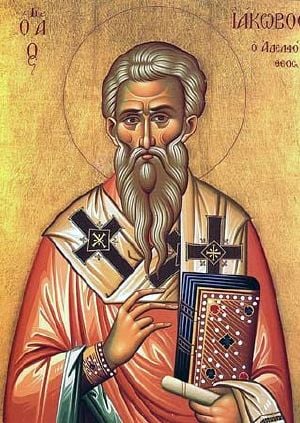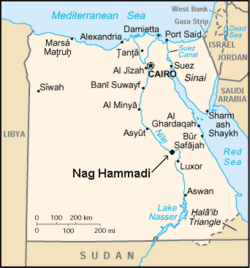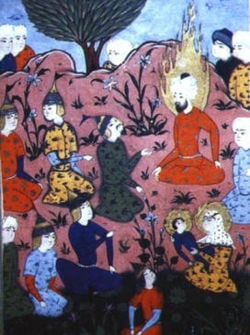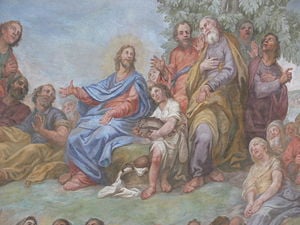The Apocryphon of James, also known as the Secret Book of James, is a pseudonymous text among the New Testament apocrypha. It describes the secret teachings of Jesus to James and Peter, given after the Resurrection but before the Ascension.
Unknown to church historians until its discovery at Nag Hammadi in the mid-twentieth century, the Apocryphon of James is an early example of the Gnostic tradition in which the risen Jesus delivers secret teachings to a special disciple or group of disciples. It takes the form of a letter from James, called elsewhere the brother of Jesus, to an unnamed reader.
The letter touches on some familiar Christian themes, but emphasizes Gnostic concepts such as the body as a type of prison for the soul, salvation through knowledge (gnosis) as well as faith, and being "full" rather than diminishing in knowledge. A distinctive characteristic of the work is that Jesus urges his disciples to become even better than he is. It also looks to future generations as going beyond the spiritual achievements of James and the other disciples.
Unlike most other Gnostic works, the Apocryphon of James emphasizes the importance of Jesus' actual crucifixion and death, and it strongly urges the disciples to follow his example of enduring persecution, rather than avoiding these sufferings. After the revelation is complete, James sends the other apostles to various locations and returns to Jerusalem, hoping that future generations will succeed in going beyond the spiritual level he himself has achieved.
Origin
None of the Church Fathers seems to mention the Apocryphon of James in their writings, implying that it had not achieved wide circulation and popularity. This may be explained by the fact that its system of Gnostic thought is not highly developed—it may even be described as "proto-Gnostic"—and other Gnostic writings may have replaced it by the time orthodox writers began their work of criticizing well-known heretical works.
The text survives in a single, damaged manuscript as the second section of the Jung Codex, the first of the 13 codices in the Nag Hammadi library. Although the text appears to be a Coptic translation from Greek, the author claims to have written in Hebrew.
Because of its emphasis on the essential need to endure persecution and martyrdom, it is unlikely that the text was written after 313, when Constantine I ended the persecution of Christians. Other clues in the text point to a composition in the second century. It is normally dated to the years 100-150 C.E.
Content
The text of "Secret James," as the book is known for short, is framed as an epistle from James to someone else whose name is obscured by the damage to the text. It refers to a previous such letter, saying "I sent you ten months ago another secret book which the Savior revealed to me."
The author describes Jesus answering the disciples' questions when he appears to them 550 days after the Resurrection, but before his final Ascension. Both James and Peter are given the secret instruction, but at the end only James appears to understand what has happened. There is little "action" in the book, as it consists almost exclusively of dialog.
Jesus gives teachings in unusual and sometimes contradictory phrases, and also offers brief parables. Peter has a hard time with this, asking, "Sometimes you urge us on to the Kingdom of God, and other times you turn us away." After the dialog ends, James sends out the 12 apostles and returns to Jerusalem, indicating that it is he, not Peter, whom Jesus has indicated as the leader of the movement.
Gnostic themes
The early verses of the letter strongly emphasize such concepts as "fullness" and not diminishing. "I say unto you, become full, in order that you may not be diminished," Jesus says. "Those who are diminished, however, will not be saved." Also used in Paul's letters, the idea of fullness (pleroma) became a common theme in later Gnostic literature.
Other typical Gnostic themes are also emphasized, such as: "Unless you receive it (the Kingdom of Heaven) through knowledge, you will not be able to find it... Understand what the Great Light is." Likewise, true disciples must avoid "wearing" flesh, that is, identifying themselves with their bodies: "None of those who have worn the flesh will be saved... Do not become arrogant on account of the light which illumines. Rather, become to yourselves in this manner—as I am to you. For I have placed myself under the curse (taking on a body), in order that you may be saved."
Jesus urges the disciples to be determined in their quest, not relying on God's grace alone. "He will love you and will make you equal with me and will consider that you have become beloved through his providence, according to your free choice." Not only are his followers to achieve equality with Jesus, but he says: "Become better than I; make yourselves like the son of the Holy Spirit."
Death and martyrdom stressed
Unlike in some other Gnostic texts, Jesus strongly emphasizes the need for his true disciples to believe that he was actually crucified. "Remember my cross and my death and you will live... None will be saved unless they believe in my cross." Such sayings appear to be intended to counter other Gnostic schools which denied that Jesus even had a physical body and was thus never actually crucified, but only appear to have been.
The disciples must also be willing to endure martyrdom themselves: "In truth I say to you, none of those who are afraid of death will be saved."
After the disciples leave and James returns to Jerusalem, he closes his letter with a benediction, continuing the theme that those who come later are likely to surpass those who first heard Jesus' secret teachings:
"I pray that the beginning may come from you, for thus I can be saved. Because they will be enlightened through me, through my faith and through another's which is better than mine, for I desire that mine become the lesser."
Relation to other texts
To most scholars, the flavor of many of the sayings in the Apocryphon of James appears clearly Gnostic in tone. The manuscript was also found among more explicitly Gnostic teachings in the Nag Hamadi Library. However, the doctrines in the Apocryphon of James certainly do not accord with the Valentinian or other developed Gnostic cosmologies.
Many of its sayings appear to be shared with the canonical Gospels, and the text includes this reference to several well known parables: "Pay attention to the teaching and understand 'The Shepherds' and 'The Seed' and 'The Building' and 'The Lamps of the Virgins' and 'The Wage of the Workers' and 'The Double Drachma' and 'The Woman'."
The references to salvation through the Cross imply familiarity with Paul's letters, or at least his teachings. On the other hand, the introduction indicates Jesus is still with his disciples 550 days after the Resurrection which contradicts the 40 days which Luke's Acts of the Apostles gives before the Ascension. Some scholars posit that the earliest version of the Apocryphon had no such connections to the canonical gospels, but that an unknown redactor knew of and referenced canonical works in the known edition.
With regard to its emphasis on the need to endure martyrdom, Secret James may intend to combat teachings such as those found in other Gnostic texts, notably the recently discovered Gospel of Judas, which argues against martyrdom, teaching that those who have true "knowledge" place no value in either the pleasures of the body or in fleshly suffering.
Notable quotations
- No one ever will enter the Kingdom of Heaven if I bid him, but rather because you yourselves are full.
- I say unto you, become full, in order that you may not be diminished. Those who are diminished, however, will not be saved.
- I say that he will love you and will make you equal with me and will consider that you have become beloved through his providence according to your free choice.
- Remember my cross and my death and you will live... No one will be saved unless they believe in my cross. But those who have believed in my cross, theirs is the Kingdom of God.
- In truth I say to you, none of those who are afraid of death will be saved. For the Kingdom of God belongs to those who have put themselves to death.
- Become better than I; make yourselves like the son of the Holy Spirit.
- Do you not know that the head of prophecy was cut off with John (the Baptist)?
- Be zealous to be saved without being urged. Rather, be ready on your own and, if possible, go before me. For this the Father will love you.
- It is also possible for you all to receive the Kingdom of Heaven: unless you receive it through knowledge, you will not be able to find it.
- Understand what the Great Light is.
- The Father does not need me. For a father does not need a son, but it is the son who needs the father.
- Pay attention to the Word. Understand Knowledge.
- Implore God often, and he will give to you.
- Truly I say to you, the Father will not forgive the sin of the soul at all, nor the guilt of the flesh. For none of those who have worn the flesh will be saved.
- The one who will receive life and believe in the Kingdom will never leave it; not even if the Father desires to banish him!
ReferencesISBN links support NWE through referral fees
- Online Translation of the Apocryphon of James www.gnosis.org. Retrieved May 13, 2008.
- Cameron, Ron. Sayings Traditions in the Apocryphon of James. Harvard theological studies, no. 34. Philadelphia: Fortress Press, 1984. ISBN 9780800670153
- Ehrman, Bart D. Lost Scriptures: Books That Did Not Make It into the New Testament. New York: Oxford University Press, 2003. ISBN 9780195182507
- Miller, Robert J. The Complete Gospels, pp. 332-342. Polebridge Press, 1992. ISBN 0944344496
Credits
New World Encyclopedia writers and editors rewrote and completed the Wikipedia article in accordance with New World Encyclopedia standards. This article abides by terms of the Creative Commons CC-by-sa 3.0 License (CC-by-sa), which may be used and disseminated with proper attribution. Credit is due under the terms of this license that can reference both the New World Encyclopedia contributors and the selfless volunteer contributors of the Wikimedia Foundation. To cite this article click here for a list of acceptable citing formats.The history of earlier contributions by wikipedians is accessible to researchers here:
The history of this article since it was imported to New World Encyclopedia:
Note: Some restrictions may apply to use of individual images which are separately licensed.



